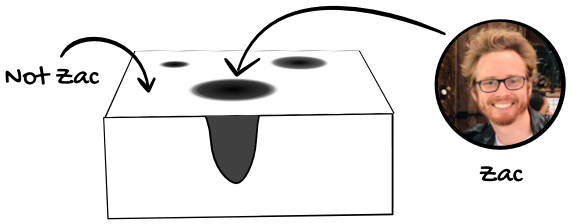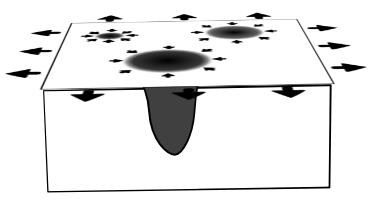"Yeah," I agreed. "Now, most of that message is very obvious on the surface level, but I want to point out this part again…"
There is no “right” or “wrong” in these matters.
But by your decisions you paint a portrait of Who You Are.
Indeed, by their decisions your states and nations have already painted such pictures.
By their decisions your religions have created lasting, indelible impressions. By their decisions your societies have produced their self-portraits, too.
Neale Donald Walsch
"Here, God is talking about systems of different sizes. He says, 'By your decisions you paint a portrait of Who You Are. Indeed, by their decisions your states and nations have painted such pictures.' So, to continue expanding our conceptual model, I want to ask you a question: who are you?"
"I'm Zac," he replied.
"Yes. You're Zac. But how can you be Zac if reality and consciousness are the same thing? If everything's the same one thing, then what defines you as being Zac, in particular?"
"Umm…"
"Here, listen to this." I began reading another snippet from The Holographic Universe.
Most mind-boggling of all are Bohm’s fully developed ideas about wholeness. Because everything in the cosmos is made out of the seamless holographic fabric of the implicate order, he believes it is as meaningless to view the universe as composed of “parts”, as it is to view the different geysers in a fountain as separate from the water out of which they flow. An electron is not an “elementary particle”. It is just a name given to a certain aspect of the holomovement. Dividing reality up into parts and then naming those parts is always arbitrary, a product of convention, because subatomic particles, and everything else in the universe, are no more separate from one another than different patterns in an ornate carpet.
This is a profound suggestion. In his general theory of relativity, Einstein astounded the world when he said that space and time are not separate entities, but are smoothly linked and part of a larger whole he called the space-time continuum. Bohm takes this idea a giant step further. He says that everything in the universe is part of a continuum. Despite the apparent separateness of things at the explicate level, everything is a seamless extension of everything else, and ultimately even the implicate and explicate orders blend into each other.
Take a moment to consider this. Look at your hand. Now look at the light streaming from the lamp beside you. And at the dog resting at your feet. You are not merely made of the same things. You are the same thing. One thing. Unbroken. One enormous something that has extended its uncountable arms and appendages into all the apparent objects, atoms, restless oceans, and twinkling stars in the cosmos.
Bohm cautions that this does not mean the universe is a giant undifferentiated mass. Things can be part of an undivided whole and still possess their own unique qualities. To illustrate what he means he points to the little eddies and whirlpools that often form in a river. At a glance, such eddies appear to be separate things and possess many individual characteristics such as size, rate, and direction of rotation, etc. But careful scrutiny reveals that it is impossible to determine where any given whirlpool ends and the river begins. Thus, Bohm is not suggesting that the differences between “things”is meaningless. He merely wants us to be aware that constantly dividing various aspects of the holomovement into “things” is always an abstraction, a way of making aspects stand out in our perception by our way of thinking.
Michael Talbot
"So," I said. "Let me ask the question again: who are you?"
"I'm Zac," he repeated.
"Yes. But you are also everything. You are a specific whirlpool in the unbroken ocean of the universe. So why isn't this backpack also Zac? Why do we call this a 'backpack,' and you a 'Zac'?"
"Because I'm not a backpack?" he guessed.
"Exactly! You're not a backpack. If everything's the same one thing, the only way we can define something in particular, is by separating it from what it is not. You can't know yourself as Zac unless you can also point to everything outside of you and label it 'not Zac.' Does that make sense?"
"Yeah, I get it," Zac said. "The only reason I can label you 'Nikki' is because I can label everything else 'not Nikki.' The only reason I can label that a 'boat' is because I can label everything else 'not a boat.'"
"Yes," I agreed. "Think about this concept in relation to a biological system, such as your physical body. Everything inside your body is working together to resist entropy and keep you in a 'frozen' particular state. To use our ocean analogy, everything is working together to keep your whirlpool spinning. I can point to your whirlpool and call it 'Zac,' and everything around it, 'not Zac'. If entropy ensued, the whirlpool would become another flat segment of the ocean. I could no longer point to it and call it 'Zac' because it would be indistinguishable from the rest of the ocean. Make sense?"

Zac nodded, and I continued. "In your body, mitochondria, a nucleus, a membrane, and various other things combine to create a single cell. Multiple cells combine to create an organ, such as a heart. Multiple organs combine to create a body. The entire system is harmoniously working together as a single organism. However, the only reason we can differentiate a cell from, say, a liver, is because a cell can be defined by what it is not. The cell is autonomous, yet its movements coordinate with everything else in the grander system of your body. The cell is a separate system, but it is also a subsystem of an organ and a subsystem of a body.
If the universe is a giant conscious system — which it is — we'd expect the universe to behave like a body. Separate 'things' behave autonomously like cells, and yet together, those 'things' are undergoing a coordinated dance that serves the system as a whole."
"Like the electrons in Bohm's plasma," Zac said. "The electrons appear to behave individually and randomly, but if you zoom out, you realize they are all undergoing a highly coordinated dance."
"Exactly," I said. "Now, I want to begin turning this abstract, conceptual model we've built into something more tangible and scientific. We're going to start connecting the dots, one by one, and in doing so, bring this model into higher and higher fidelity. Let's return to our model..."

"The ocean represents the universe. Whirlpools represent individual 'things' in the universe. They are like frozen vortices that are something in particular, but still a part of the whole. There is a mathematical pull towards entropy (a calm, flat ocean) and a mathematical resistance to entropy. This resistance maintains the whirlpools as something 'in particular.'
We've already deduced, from first principles, that the universe is a conscious system. If we reduce this to a more tangible, mathematical representation, the entire universe is a neural network. This means-"
"You never really explained that properly," Zac interjected. "You just told me a neural network is an information processing paradigm. It's just a collection of beliefs."

